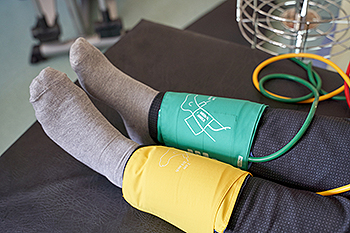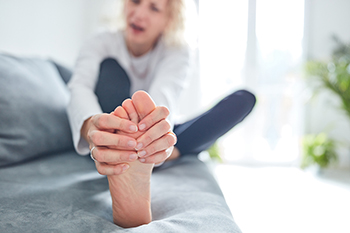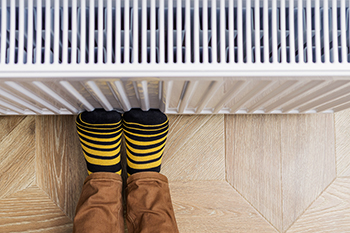Items filtered by date: February 2022
Plantar Warts Can Be Treated!
Women and Peripheral Artery Disease
 Peripheral artery disease (PAD), a condition that causes poor blood flow in the lower limbs, affects both men and women. After age 60, prevalence of PAD is higher in men than in women, yet women tend to be underdiagnosed and undertreated. This is because women are more likely to present with atypical symptoms, such as lower limb pain while exercising and while at rest. Many women present with no symptoms at all. For this reason, it is particularly important for women to undergo vascular testing to determine if they may have PAD. To learn more about this condition and get tested, schedule an appointment with a podiatrist near you.
Peripheral artery disease (PAD), a condition that causes poor blood flow in the lower limbs, affects both men and women. After age 60, prevalence of PAD is higher in men than in women, yet women tend to be underdiagnosed and undertreated. This is because women are more likely to present with atypical symptoms, such as lower limb pain while exercising and while at rest. Many women present with no symptoms at all. For this reason, it is particularly important for women to undergo vascular testing to determine if they may have PAD. To learn more about this condition and get tested, schedule an appointment with a podiatrist near you.
Peripheral artery disease can pose a serious risk to your health. It can increase the risk of stroke and heart attack. If you have symptoms of peripheral artery disease, consult with one of our podiatrists from PA Foot & Ankle Associates. Our doctors will assess your condition and provide you with quality foot and ankle treatment.
Peripheral artery disease (PAD) is when arteries are constricted due to plaque (fatty deposits) build-up. This results in less blood flow to the legs and other extremities. The main cause of PAD is atherosclerosis, in which plaque builds up in the arteries.
Symptoms
Symptoms of PAD include:
- Claudication (leg pain from walking)
- Numbness in legs
- Decrease in growth of leg hair and toenails
- Paleness of the skin
- Erectile dysfunction
- Sores and wounds on legs and feet that won’t heal
- Coldness in one leg
It is important to note that a majority of individuals never show any symptoms of PAD.
Diagnosis
While PAD occurs in the legs and arteries, Podiatrists can diagnose PAD. Podiatrists utilize a test called an ankle-brachial index (ABI). An ABI test compares blood pressure in your arm to you ankle to see if any abnormality occurs. Ultrasound and imaging devices may also be used.
Treatment
Fortunately, lifestyle changes such as maintaining a healthy diet, exercising, managing cholesterol and blood sugar levels, and quitting smoking, can all treat PAD. Medications that prevent clots from occurring can be prescribed. Finally, in some cases, surgery may be recommended.
If you have any questions, please feel free to contact one of our offices located in Allentown, Easton, Northampton, and Chew Street in Allentown, PA . We offer the newest diagnostic and treatment technologies for all your foot care needs.
Ways to Keep Blisters From Forming
 When fluid filled lesions form on the feet because of pressure and/or friction, they form blisters. Blisters can be very painful and can form from a variety of factors. Common factors that can cause blisters to form include wearing shoes that are too stiff or don’t fit right, too much moisture in the feet, foot deformities, and wrinkled socks. There are some things that can be done to help prevent blisters that include keeping the feet dry, wearing socks and shoes that fit correctly, and making sure to check the feet for any rubbing or tenderness that is caused by shoes. Patients who do form blisters on the feet should make sure to not pop them because they usually clear up after around 3-7 days. However, patients who have persistent blisters, are diabetic or believe that their blisters are infected would be wise to consult with a podiatrist.
When fluid filled lesions form on the feet because of pressure and/or friction, they form blisters. Blisters can be very painful and can form from a variety of factors. Common factors that can cause blisters to form include wearing shoes that are too stiff or don’t fit right, too much moisture in the feet, foot deformities, and wrinkled socks. There are some things that can be done to help prevent blisters that include keeping the feet dry, wearing socks and shoes that fit correctly, and making sure to check the feet for any rubbing or tenderness that is caused by shoes. Patients who do form blisters on the feet should make sure to not pop them because they usually clear up after around 3-7 days. However, patients who have persistent blisters, are diabetic or believe that their blisters are infected would be wise to consult with a podiatrist.
Blisters may appear as a single bubble or in a cluster. They can cause a lot of pain and may be filled with pus, blood, or watery serum. If your feet are hurting, contact one of our podiatrists of PA Foot & Ankle Associates. Our doctors can provide the care you need to keep you pain-free and on your feet.
Foot Blisters
Foot blisters are often the result of friction. This happens due to the constant rubbing from shoes, which can lead to pain.
What Are Foot Blisters?
A foot blister is a small fluid-filled pocket that forms on the upper-most layer of the skin. Blisters are filled with clear fluid and can lead to blood drainage or pus if the area becomes infected.
Symptoms
(Blister symptoms may vary depending on what is causing them)
- Bubble of skin filled with fluid
- Redness
- Moderate to severe pain
- Itching
Prevention & Treatment
In order to prevent blisters, you should be sure to wear comfortable shoes with socks that cushion your feet and absorb sweat. Breaking a blister open may increase your chances of developing an infection. However, if your blister breaks, you should wash the area with soap and water immediately and then apply a bandage to the affected area. If your blisters cause severe pain it is important that you call your podiatrist right away.
If you have any questions, please feel free to contact one of our offices located in Allentown, Easton, Northampton, and Chew Street in Allentown, PA . We offer the newest diagnostic and treatment technologies for all your foot care needs.
Top 4 Conditions That Cause Cold Feet
If your feet always feel cold, it may be due to one of the following four reasons. 1) You may have poor circulation. Feet need a steady flow of blood to keep them warm. Poor circulation causes blood vessels to constrict which limits the amount of blood traveling to the feet. 2) You may have Raynaud’s syndrome. This is a condition where blood vessels that supply the skin with blood constrict and spasm temporarily, thereby limiting blood flow. This may even cause your skin to change colors temporarily as blood flow is cut off and then returns. 3) You may be overly stressed or anxious. The body’s reaction to extreme stress or anxiety may trigger a “fight or flight” response which can direct blood flow towards larger organs—which are more critical to survival—and away from the extremities. 4) You may have anemia, which is an insufficient amount of red blood cells. Anemia reduces the amount of oxygen in the blood, sometimes causing cold feet. If you are concerned about your feet always feeling cold, contact a podiatrist to determine what the underlying cause may be and to get the appropriate treatment.
Poor circulation is a serious condition and needs immediate medical attention. If you have any concerns with poor circulation in your feet contact one of our podiatrists of PA Foot & Ankle Associates. Our doctors will treat your foot and ankle needs.
Poor Circulation in the Feet
Poor blood circulation in the feet and legs is can be caused by peripheral artery disease (PAD), which is the result of a buildup of plaque in the arteries.
Plaque buildup or atherosclerosis results from excess calcium and cholesterol in the bloodstream. This can restrict the amount of blood which can flow through the arteries. Poor blood circulation in the feet and legs are sometimes caused by inflammation in the blood vessels, known as vasculitis.
Causes
Lack of oxygen and oxygen from poor blood circulation restricts muscle growth and development. It can also cause:
- Muscle pain, stiffness, or weakness
- Numbness or cramping in the legs
- Skin discoloration
- Slower nail & hair growth
- Erectile dysfunction
Those who have diabetes or smoke are at greatest risk for poor circulation, as are those who are over 50. If you have poor circulation in the feet and legs it may be caused by PAD and is important to make changes to your lifestyle in order to reduce risk of getting a heart attack or stroke. Exercise and maintaining a healthy lifestyle will dramatically improve conditions.
As always, see a podiatrist as he or she will assist in finding a regimen that suits you. A podiatrist can also prescribe you any needed medication.
If you have any questions please feel free to contact one of our offices located in Allentown, Easton, Northampton, and Chew Street in Allentown, PA . We offer the newest diagnostic and treatment technologies for all your foot and ankle needs.
Arthritis Can Cause Pain in the Feet and Ankles
Metatarsalgia 101
 The term metatarsalgia refers to any condition that causes pain in the ball of the foot, also known as the metatarsal region. The most common cause of metatarsalgia is pain from inflammation in the metatarsal heads (ball of the foot) that puts pressure on the front of the foot. There are a variety of other causes that can lead to pain in this area of the foot including bunions, overuse of the ball of the foot, aging, having higher arches, arthritis, gout, or diabetes. Other factors, such as being overweight or wearing high heels, can also lead to stress in this area. If you are dealing with discomfort or pain in the ball of your foot, it may be a good idea to consult with a podiatrist for a proper diagnosis and to discuss various treatment options.
The term metatarsalgia refers to any condition that causes pain in the ball of the foot, also known as the metatarsal region. The most common cause of metatarsalgia is pain from inflammation in the metatarsal heads (ball of the foot) that puts pressure on the front of the foot. There are a variety of other causes that can lead to pain in this area of the foot including bunions, overuse of the ball of the foot, aging, having higher arches, arthritis, gout, or diabetes. Other factors, such as being overweight or wearing high heels, can also lead to stress in this area. If you are dealing with discomfort or pain in the ball of your foot, it may be a good idea to consult with a podiatrist for a proper diagnosis and to discuss various treatment options.
Foot Pain
Foot pain can be extremely painful and debilitating. If you have a foot pain, consult with one of our podiatrists from PA Foot & Ankle Associates. Our doctors will assess your condition and provide you with quality foot and ankle treatment.
Causes
Foot pain is a very broad condition that could be caused by one or more ailments. The most common include:
- Bunions
- Hammertoes
- Plantar Fasciitis
- Bone Spurs
- Corns
- Tarsal Tunnel Syndrome
- Ingrown Toenails
- Arthritis (such as Gout, Rheumatoid, and Osteoarthritis)
- Flat Feet
- Injury (from stress fractures, broken toe, foot, ankle, Achilles tendon ruptures, and sprains)
- And more
Diagnosis
To figure out the cause of foot pain, podiatrists utilize several different methods. This can range from simple visual inspections and sensation tests to X-rays and MRI scans. Prior medical history, family medical history, and any recent physical traumatic events will all be taken into consideration for a proper diagnosis.
Treatment
Treatment depends upon the cause of the foot pain. Whether it is resting, staying off the foot, or having surgery; podiatrists have a number of treatment options available for foot pain.
If you have any questions, please feel free to contact one of our offices located in Allentown, Easton, Northampton, and Chew Street in Allentown, PA . We offer the newest diagnostic and treatment technologies for all your foot care needs.



